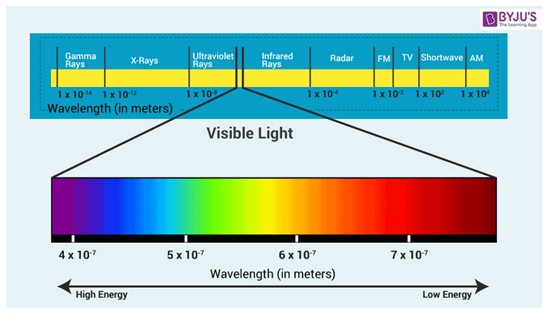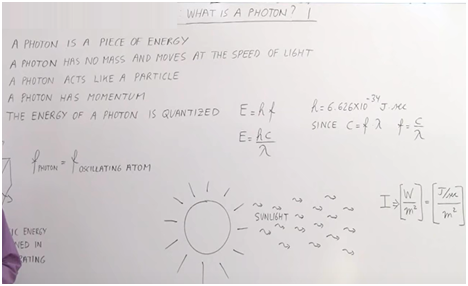Light wave

Our eyes are sensitive to light located in a very small region of the electromagnetic spectrum labeled “visible light.” This “visible light” corresponds to a wavelength range of 400 – 700 nanometers (nm) and a range of colors from violet to red. The human eye cannot “see” radiation at wavelengths outside the visible spectrum. The visible colors from shortest to longest wavelength are: violet, blue, green, yellow, orange and red. Ultraviolet light has a shorter wavelength than visible violet light. Infrared radiation has a longer wavelength than visible red light. White light is a mixture of visible spectrum colors. Black is completely lightless. The most important energy source for the earth is the sun. Sunlight consists of the entire electromagnetic spectrum. The wavelength of violet light is about 400 nm and the frequency is about 7.5*1014 Hz. The wavelength of red light is about 700 nm and the frequency is about 4.3*1014 Hz.
Plasma Light


Plasma glows because of “spontaneous emission,” which basically means that ions, atoms, or molecules are more energetic than stable, and thus become unstable, and the particles emit photons. Photon energy is inversely proportional to the wavelength of electromagnetic waves. The shorter the wavelength, the higher the photon energy, and the longer the wavelength, the lower the photon energy. Photons can be created and destroyed while maintaining energy and momentum.
Cancer Concerns on CRTs vs Plasma vs LCD TVs

Plasma TVs emit small amounts of ultraviolet (UV) radiation, but less than typical tube (CRT) TVs. Although all CRT and plasma TVs must comply with the 1969 FDA (Food and Drug Administration) guidelines for radiated emissions from TVs, prolonged sitting/lying watching TV (especially large TVs) is not only associated with cancer, but also Have other medical conditions such as diabetes and heart disease/stroke. LCD and LED TVs may not emit radiation, but they expose you to light at night, which can turn off melatonin production and increase your risk of cancer, especially breast cancer. Finally, the study found that sitting and watching TV for long periods of time was associated with an increased risk of colorectal cancer in women.

